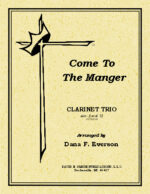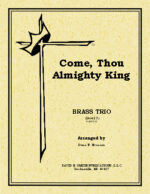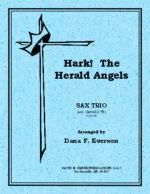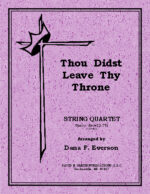-
Come To The Manger
$8.00An accompanied clarinet trio opening with an exciting motive. The first rendition is in block harmonies with occasional rhythmic punctuations. The next section has subtle contrapuntal statements amongst all parts giving a joyous texture. After a modulation the ensemble alternates between solo statements and full ensemble giving contrasts in texture and color. Another modulation ensues where imitative motives take place through the voices only to come together in a solid fashion for an exciting ending.
-
Come Thou Almighty King
$10.00An accompanied brass trio for trumpet, horn (trumpet) and trombone (baritone horn TC). The piece begins with a motive that is imitative and builds in intensity until the theme is presented in the trombone with punctuations from the upper voices. It continues much in this manner until the chorus erupts in block harmonies. After a modulation and meter change, the trio presents a fanfare style until it abruptly reverts to the original meter. And then a more solemn manner, all the while gaining strength until a conclusive ending.
-
Hark The Herald Angels Sing
$8.00An accompanied saxophone trio for altos and optional tenor. The piece begins in a lively fashion starting quietly and adding more parts as it crescendos up to the opening of the tune in full ensemble scoring. The chorus passes active melodic portions amongst the parts until it flairs up to a triumphal statement. After a modulation the theme is passed around in a hocket-like fashion and then explodes into a block set of harmonies adding more and more rhythmic movement. The concluding section uses multiple dynamic and rhythmic shifts to cause contrasts up to a resounding conclusion
-
Thou Didst Leave Thy Throne
$9.00A string quartet with optional violin for viola. After a full ensemble introduction the piece gives way to a duet in the viola and cello. With the violins entering one at a time the piece now becomes full with all parts present gravitating to motivic development moving to a modulation. The next section gives the tune to the cello with the upper lines adding punctuated accompanied figures. The next section uses motivic patterns while passing portions of the tune to the various players. A modulation- then the parts become increasingly more active in a variation style. With a solid ensemble altering the melody; a brake; then, repose.
-
-
-
-
-
-
-
-
-
-
-
-
-
-
-
-
-
O Come, O Come Emmanuel
$6.50(3,4,5 octave) with orchestra- included in the Carols of the Bells, Vol II (#302214L- orchestra set)
-





